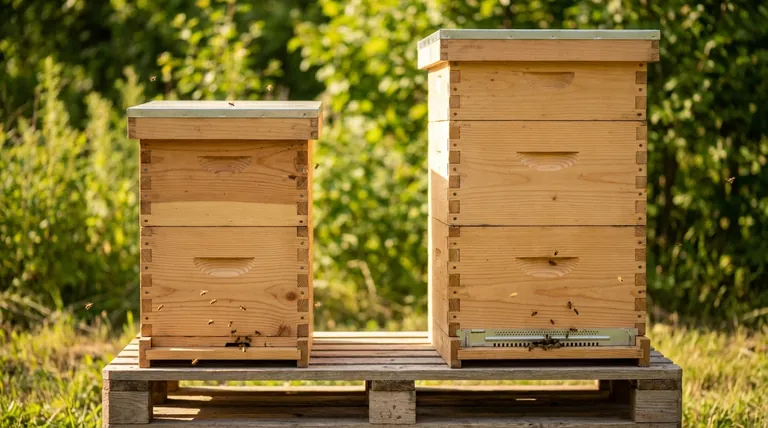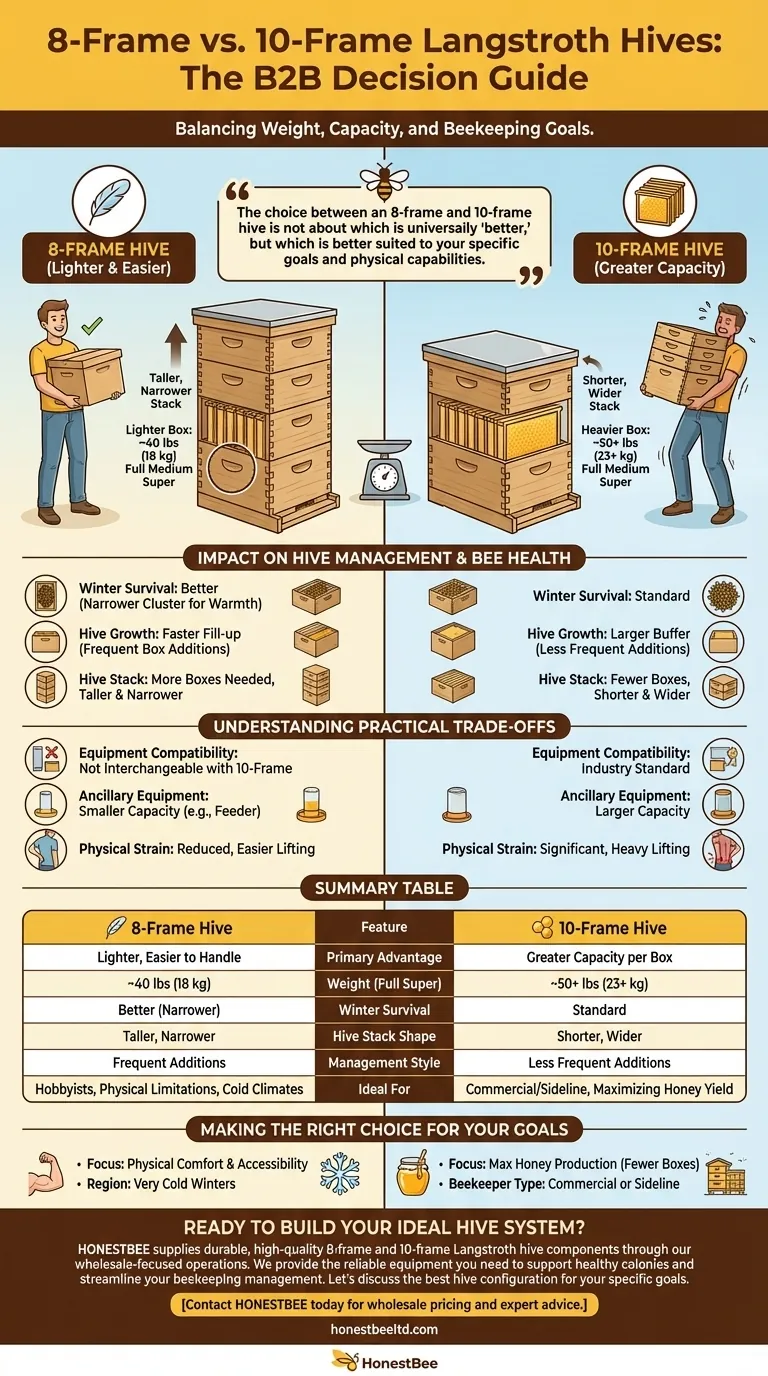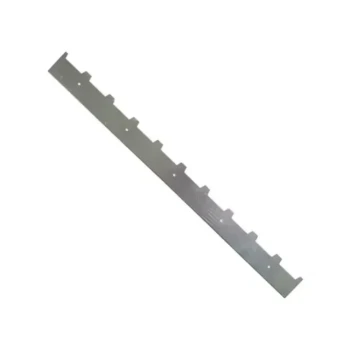The fundamental difference between an eight-frame and ten-frame Langstroth hive is a direct trade-off between weight and capacity. Ten-frame equipment holds more frames, leading to more space for bees and honey in a single box, but it is significantly heavier. Eight-frame gear is lighter and easier for a beekeeper to handle, but it requires more boxes to achieve the same total volume.
The choice between an 8-frame and 10-frame hive is not about which is universally "better," but which is better suited to your specific goals and physical capabilities. Your decision hinges on balancing the convenience of lighter equipment against the efficiency of larger-volume boxes.

The Core Trade-off: Weight vs. Volume
The most immediate difference you will notice between the two systems is the weight. This factor influences every interaction you have with the hive, from initial setup to final harvest.
The Advantage of Lighter Equipment (8-Frame)
An 8-frame hive box is narrower and therefore lighter than its 10-frame counterpart. This is a significant advantage during hive inspections and honey harvesting, which require lifting heavy, bee-filled boxes.
For many beekeepers, especially those with physical limitations, the reduced weight is the single most important factor. It makes the hobby more accessible and sustainable long-term.
The Benefit of Greater Capacity (10-Frame)
A 10-frame hive body provides more room for the queen to lay eggs and for workers to store honey and pollen in a single box. This larger volume can support a larger colony population.
With more space per box, a 10-frame hive may require fewer boxes overall to achieve the same internal volume, resulting in a shorter, wider hive stack.
Impact on Hive Management and Bee Health
Beyond the simple weight difference, the hive's internal dimensions affect how the bees live and how you manage them throughout the year.
Winter Survival and Bee Preference
The narrower, more compact shape of an 8-frame hive is often considered more optimal for honey bees, especially in winter. It more closely resembles the tall, narrow cavities wild bees naturally choose.
This smaller cross-section makes it easier for the winter cluster to stay warm and move up the hive to reach its honey stores, potentially improving overwintering success.
Hive Growth and Expansion
Because they have less space, 8-frame hives tend to fill up with brood and honey faster. This requires the beekeeper to be more diligent about adding new boxes (supers) to prevent the colony from becoming overcrowded and swarming.
Conversely, a 10-frame hive offers a larger buffer, giving the bees more room to expand before another box is needed.
Overall Hive Dimensions
While individual 8-frame boxes are lighter, a thriving colony will require more of them. This results in a taller, narrower hive stack that can be more prone to tipping over if not placed on a level, stable surface. A 10-frame hive will be shorter and more stable for the same internal volume.
Understanding the Practical Trade-offs
Your choice has cascading effects on cost, compatibility, and the sheer physical effort required for beekeeping.
Equipment Compatibility and Cost
While frames of the same depth (e.g., "deep" or "medium") are interchangeable between 8-frame and 10-frame boxes, the boxes themselves, along with top covers and bottom boards, are not. You must commit to one size for a given hive.
Component by component, 8-frame equipment is often slightly cheaper due to its smaller size.
Ancillary Equipment Differences
The size difference also applies to accessories like feeders. A typical top feeder for a 10-frame hive might hold around four gallons of syrup, while its 8-frame equivalent will hold closer to three gallons.
The Physical Strain of Beekeeping
Do not underestimate the weight of honey. A full, medium 10-frame honey super can weigh over 50 pounds (23 kg). The physical strain of lifting these boxes is a primary reason many experienced beekeepers switch from 10-frame to 8-frame equipment.
Making the Right Choice for Your Goals
Your beekeeping journey will be more successful if your equipment matches your personal objectives and physical reality.
- If your primary focus is physical comfort and accessibility: The 8-frame hive is the clear choice, as its lighter components make every task easier.
- If your primary focus is maximizing honey production with fewer boxes: The 10-frame hive offers more capacity per box, potentially leading to a larger harvest with less equipment.
- If you live in a region with very cold winters: The 8-frame configuration provides a thermal advantage that can help your colony survive the cold.
- If you are a commercial or sideline beekeeper: The 10-frame hive is the industry standard due to its space efficiency, though this is changing as more recognize the benefits of lighter gear.
Ultimately, the best hive is the one you can manage safely and consistently, ensuring a healthy colony and an enjoyable beekeeping experience.
Summary Table:
| Feature | 8-Frame Hive | 10-Frame Hive |
|---|---|---|
| Primary Advantage | Lighter, easier to handle | Greater capacity per box |
| Weight (Full Medium Super) | ~40 lbs (18 kg) | ~50+ lbs (23+ kg) |
| Winter Survival | Better (narrower cluster) | Standard |
| Hive Stack Shape | Taller, narrower | Shorter, wider |
| Management Style | More frequent box additions | Larger buffer, less frequent additions |
| Ideal For | Hobbyists, those with physical limitations, cold climates | Commercial/sideline beekeepers, maximizing honey yield |
Ready to Build Your Ideal Hive System?
Whether you're a commercial apiary scaling up operations or a distributor stocking for the season, choosing the right hive equipment is critical for efficiency and bee health. HONESTBEE supplies durable, high-quality 8-frame and 10-frame Langstroth hive components through our wholesale-focused operations.
We provide the reliable equipment you need to support healthy colonies and streamline your beekeeping management. Let's discuss the best hive configuration for your specific goals.
Contact HONESTBEE today for wholesale pricing and expert advice.
Visual Guide

Related Products
- Professional Hive Top Bee Feeder for Beekeeping
- Telescopic Beehive Outer Cover Lid Roof with Galvanised Sheeting for Langstroth Hive and Beehive Outer Cover
- Professional Bee Frame Wiring Tool with Integrated Tensioning System by HONESTBEE
- 3.5L Plastic Beehive Frame Feeder Deep Frame Water Feeder for In Hive Use
- Professional Insulated Winter Hive Wrap for Beekeeping
People Also Ask
- What is the best bee feeder for a hive? Choose the Right Feeder for Your Apiary's Scale
- How to use a top feeder in a beehive? A Guide to Effective Beehive Feeding
- What is a top feeder for bees? Maximize Colony Health with Efficient Feeding
- How is the plywood floor fitted into the hive-top feeder? Ensure Longevity with a Floating Floor Design
- What are the advantages of hive top feeders? Maximize Feeding Efficiency for Your Apiary



















